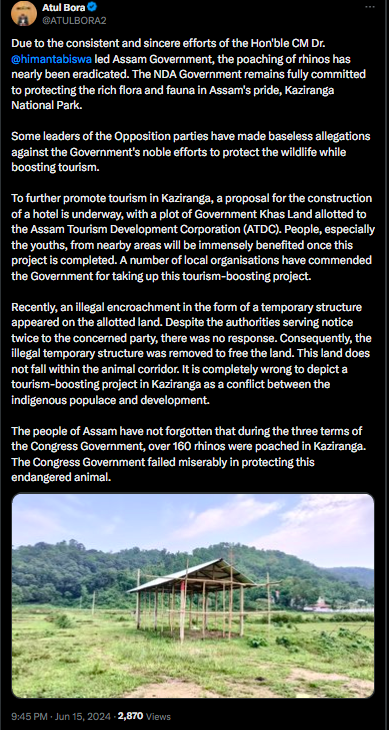Assam: NGT Suo Motu Case, as Locals Oppose Luxury Hotels Near Kaziranga

Locals confront the police. Image source: Soneswar Narah, Chief advisor, Jeepal Krishak Shramik Sangha.
“Even if one has all the money in the world, he can’t build a second Kaziranga anywhere in the world”, these words are a reality. S.K. Shil Sharma, former long-term DFO (Divisional Forest Officer) of Kaziranga National Park and Tiger Reserve (KNPTR), uttered theses words while explaining the unique geo-physical characteristics of Kaziranga and how it is a biodiversity hotspot, while speaking with this writer.
A UNESCO world heritage site, KNPTR has been entangled in controversies recently with the latest development being the registering of a suo motu case by NGT (National Green Tribunal) on August 5, 2024, over the proposed luxury hotels near the National Park.
The Issue in Brief
The controversy is rooted in the Assam government’s plan to clear the path for setting up luxury hotels near KNPTR for boosting tourism. Two groups, namely, Hyatt and the Tata group are planning to set up big hotels in Kaziranga. Assam Chief Minister Himanta Biswa Sarma signed a MoU with the Tata Group on August 3, or a five-star hotel in Kaziranga.
Notably, the Tata group has also started a semiconductor industry in the premises which once belonged to a government-operated paper mill at Jagiroad, which was one of the largest units of Hindustan Paper Corporation, established in the 1970s. The ruling Bharatiya Janata Party’s (BJP) promise of reviving the paper mill in their election campaign and people’s protests could not save the indigenous industry.
The place for Hyatt and Tata’s hotels and resorts is in the fringes of KNPTR, the Inle Pothar area and the Hatikhuli tea estate. This tea estate is owned by Tata’s associate, Amalgamated Plantation Pvt. Ltd.
While the Assam government’s MoU with the Tata group was signed, the one with the Hyatt group was signed in 2021-22, Pranab Doley, president of Greater Kaziranga Land and Human Rights Protection Committee told Newsclick. Doley also said that he had filed an RTI (Right to Information) application on the MoU with the revenue department. As a response, he claimed he was asked to approach the ATDC (Assam Tourism Development Corporation).
“We have filed an RTI with the ATDC, but even after a month, there is no response”, said Doley, adding that his organisation was fighting for the land rights of the people farming there while opposing the hotel construction, which, they fear will be a threat to the ecology of Kaziranga.
The Inle Pothar area is known to be frequented by elephants and is their wandering ground, especially during the flood season. For generations, people and wildlife have co-existed in the area. The upcoming hotels will add a worry to the ecological balance, which may result in more human-elephant conflict in future.
In addition, in and around the pothar (a large field, especially cultivable one), locals, including the adivasis, have been cultivating paddy for generations. They built makeshift structures to look after their crop here during the season of rice cultivation. The rice produced by them fills the stomach of not only the growers, but also of wildlife, including elephants.
The setting up of big hotels will impact their livelihoods and their rights over the land. However, the government claims that the land belongs to it, which is contrary to the claims of local residents like Lokhu Gowala, who said they had been paying annual land revenue for years.
The Chronology
In May this year, many of those who farm on the land in Inle Pothar were served notices from the circle office of Bokakhat declaring that the land belonged to the ATDC. Since then, tension start brewing. Notably, the paddy cultivation period in Assam starts from April-May. On June 7, the administration and police rased the makeshift structure of Lokhu Gowala to the ground, which the locals said, was the first use of “brute force” in the area. The locals also had a confrontation with the police on June 15.
Some locals told this writer that their ancestors had cultivated the land, emphasising that the process continues for generations. Some of them claimed that they even had Myadi Pattas (the legal permanent land-holding certificate). But,the government claims that the land belongs to ATDC.
In a post on social media site, X, agriculture minister and the local MLA (Bokakhat constituency), Atul Bora, wrote that the contested land was allocated to ATDC for tourism development.

Minister Atul Bora’s post on X. Taken from Bora’s X handle.
Those who were served notices have also approached the circle office and the office of the SDO (Sub Divisional Officer) civil, Bokakhat, but allegd that they had to return without an answer from the authorities. Notably, the makeshift structures are not permanent residential places of farmers. These are built every year during the paddy growing season.
In July-end, the media flashed a report about the concern raised by UNESCO advisory committee ICOMOS (International Council on Monuments and Sites) about the proposed hotels. ICOMOS expert member Sanjib Kr. Borkakoti sent a letter to the tourism department of Assam government on June 18, and after no response, sent another letter to the same authority, this time by Dilip Changkakoty, zonal representative, NE zone, ICOMOS India. But there was no response till the media highlighted it in July.
Its need to be mentioned here that the Jeepal Krishak Shramik Sangha raised the issue of ecological misbalance and was the first organization that questioned the national and international conservation and environmental NGOs working in Kaziranga about their silence over the issue. However, Aranyak, a conservation NGO, raised concerns over the proposed hotel constructions, cautioning that tourism interests must not undermine the conservation interests in a biodiversity hotspot like Kaziranga.
On August 1, police resorted to lathicharge the protestors who joined a demonstration called by the ATTSA (Assam Tea Tribes Students Union). Several got injured. On August 3, the Assam government signed the MoU with Tatas and on August 5, the NGT registered a suo motu case.
Can KNPTR Lose UNESCO World Heritage Tag?
Newsclick spoke to Sanjib Borkakoti for his views on the matter. Borkakoti is an expert member of the ICOMOS and also a member of IUCN (International Union of Conservation of Nature). He said UNESCO depended on the reports of three committees, namely the ICOMOS, IUCN and ICCROM (International Centre for the Study of the Preservation and Restoration of Cultural Property), to decide on declaring a world heritage site.
“The concerns raised by ICOMOS over the proposed hotel construction near KNPTR will be discussed in the India committee and it may go to UNESCO. In that case, the UN body will review again and decide about KNPTR’s world heritage tag. See, the world heritage tag is not permanent and it depends on several factors. The Manas national park in Assam, another world heritage site, also lost its tag once during the peak of Bodo insurgency when the forest was massively destroyed”, he said.
Borkakoti said that authenticity and integrity were the two main factors that the UNESCO world heritage site tag depended on. “KNPTR is conferred with the tag because of its unique and rich biodiversity and also the management of its resources”, he said, adding that “world heritage is declared to preserve the assets of a site. Declaring the world heritage site means the site is a property of the world and has to be preserved. It is the responsibility of the local governments to maintain a site.”
On their concern over hotel construction in and around the national park, Borkakoti said the Inle Pothar area was an elephant corridor and is frequented by the elephants. “Though this particular spot is not within the boundary of the KNPTR, world heritage demands buffer zones as well. If hotels are constructed here, then the area won’t be spared from sound and air pollution. Moreover, there will be lighting in the night as well, disturbing the animals,” he added.
He, however, said if the hotels were to be constructed, then it could be at Jakhalabnadha or Bokakhat, which are a bit far away from the animal corridors. “There are already lots of hotels and resorts in Kaziranga, and even they are not recommended. The Hyatt will be larger than others,” he added.
It’s worth mentioning that in 2015-16, there was a proposal for a helipad in the same area, but depending upon similar concerns of environmental and wildlife experts and the report by P Shivkumar, the then director of KNPTR, the government dropped the plan.
Kaziranga Floods and Animal Corridors
The main forest of KNPTR is on the left side of the NH 715 (earlier NH 37) if one moves from Assam’s capital Guwahati. The park has river Brahmaputra on its northern border, while the majestic Karbi Hills is on the south of the highway. The animal corridors are formed crossing the NH, which are nine in total, with Kanchanjuri being the largest one, experts said. The animals come from the forest and move toward the highlands of the Karbi Hills. This becomes especially important during the monsoon season when floods submerge the park. These corridors are already severely affected due to constructions.
Explaining the uniqueness of flooding in KNPTR, S K Shil Sharma, told Newsclick that 60% of the national park consisted of grassland along with several water bodies inside. “Though Brahmaputra forms the northern boundary of the park, the flood inside it takes place due to back flow of water from the mighty river. This is a unique phenomenon with KNPTR’s flooding. When Brahmaputra water rises to a critical point, the extra water enters the park via the Diffloo channel near Burhapahar,” he added.
The topography of KNPTR is such that its slope is from east (high) to west (low). The Brahmaputra meets the park’s boundary in eastern side and the flood water does not enter through this end. The Buhrapahar is towards west and the flood water back-flows from this side when Brahmaputra’s water rises to a level entering via the Diffloo channel.
“The flood recharges the water bodies inside the park and washes away the garbage from it. It is during the flood that fishes of various species from KNPTR’s water bodies go out to Brahmaputra. In fact, KNPTR such serves as a breeding ground of fishes”, Sharma elaborated. He said that the natural animal corridor is towards Karbi Hills at south and animals cross the highway. During flood the migration intensifies.
Sharma was of the view that the number of tourists should be restricted in Kaziranga. “Often tourists complain about not being able to see any animal during their safaris. If hundreds of safari cars ply through the park, the animals are obviously disturbed and they hide. There should be a real assessment of how many tourists can be allowed in a season. Moreover, the animal corridors and the buffer areas are also need to be protected,” he said.
Uttam Saikia, ex-honorary warden of KNPTR, voiced similar concerns. On the threat to the ecological balance of Kaziranga, Saikia told Newsclick,“It’s human beings that have caused problems. For animals, any obstruction is unnatural, be it a small house or settlement or big constructions. We, the humans, need to rectify ourselves.”
On animal movement, he said, “The animals prefer age-old routes. Although some artificial highlands have been made inside the park, the animals prefer to take the traditional corridor to the Karbi Hills highlands, especially during floods.”
“KNPTR is a floodplain ecosystem, which is rare in the world that has given Kaziranga its unique characteristics. The park houses several oxbow lakes (remains of bends of a river and a stagnant water body) and the grasslands near such lakes are where the eastern swamp deer survive, which is a rare species”, Saikia added.
The writer is an independent journalist based in Assam.
Get the latest reports & analysis with people's perspective on Protests, movements & deep analytical videos, discussions of the current affairs in your Telegram app. Subscribe to NewsClick's Telegram channel & get Real-Time updates on stories, as they get published on our website.























